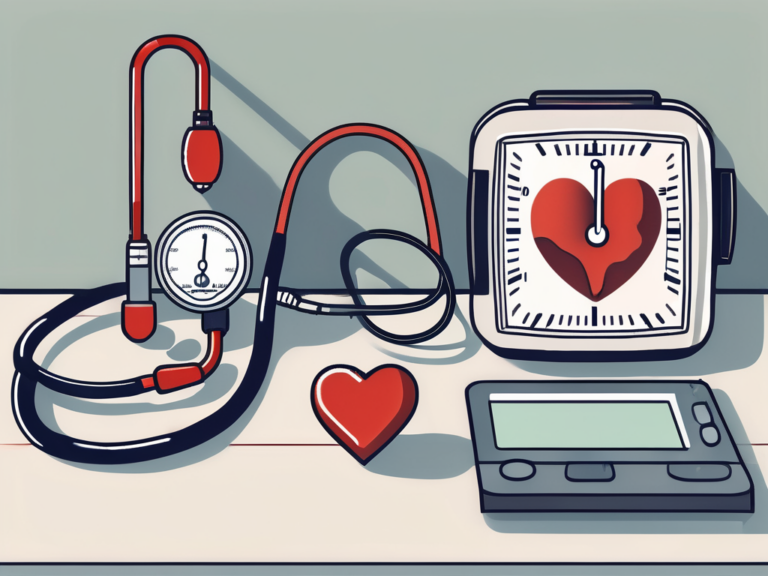How to Test Your Heart at Home: A Comprehensive Guide
Your heart is a vital organ that plays a crucial role in keeping you alive and well. Taking care of your heart health is essential for overall well-being. Regular heart check-ups are an important aspect of maintaining a healthy heart. This comprehensive guide will provide you with the knowledge and tools you need to test your heart at home, allowing you to take better control of your cardiovascular health.
Understanding the Importance of Heart Health
The heart is truly an incredible organ. Situated at the center of your circulatory system, it tirelessly pumps blood throughout your body, ensuring that every cell receives the oxygen and nutrients it needs to function optimally. But its role doesn’t stop there. The heart also plays a vital role in removing waste products from your body and carries hormones that regulate various functions, such as metabolism and growth.
Imagine your heart as a dedicated courier, tirelessly delivering packages of life-sustaining supplies to every corner of your body. Without this efficient delivery system, your body would suffer, like a city without a functioning transportation network. It is no wonder, then, that maintaining a healthy heart is crucial for overall well-being.
Regular heart check-ups are not just a routine inconvenience; they are a proactive approach to safeguarding your heart’s health. These check-ups allow medical professionals to monitor your heart’s function and detect any potential issues early on. Think of it as a preventive measure, like regular maintenance for your car, ensuring that any potential problems are identified and addressed before they become serious.
By staying on top of your heart health, you can take charge of your well-being and make informed decisions about your lifestyle. Whether it’s adopting a heart-healthy diet, engaging in regular exercise, or managing stress effectively, these check-ups provide you with the knowledge and guidance to maintain a healthy heart for a long and fulfilling life.
Basic Anatomy of the Heart
The heart is a remarkable organ, intricately designed to ensure the continuous circulation of blood throughout the body. Its structure consists of four chambers, each with its specific role, working harmoniously to maintain our overall well-being. Let’s delve deeper into the fascinating details of the heart’s anatomy.
Starting with the upper chambers, known as the atria, these two small but mighty compartments play a crucial role in the heart’s pumping mechanism. The right atrium receives deoxygenated blood from the body, which has been depleted of oxygen and filled with waste products. This blood, often portrayed as blue in diagrams, is then propelled into the right ventricle through a valve called the tricuspid valve.
Once in the right ventricle, the deoxygenated blood is ready for its journey to the lungs. With a powerful contraction, the right ventricle pushes the blood through another valve, called the pulmonary valve, and into the pulmonary artery. From there, the blood is transported to the lungs, where it undergoes a remarkable transformation.
Within the lungs, the deoxygenated blood exchanges its carbon dioxide, a waste product, for fresh oxygen. This exchange takes place in the tiny air sacs called alveoli, where the oxygen diffuses into the blood while carbon dioxide is released into the lungs to be exhaled. Now enriched with life-giving oxygen, the blood returns to the heart, ready to embark on its next adventure.
As the oxygenated blood enters the heart, it flows into the left atrium, which acts as a receiving chamber. From there, it is swiftly propelled into the left ventricle through the mitral valve, a valve of utmost importance in maintaining the heart’s efficiency. The left ventricle, often referred to as the powerhouse of the heart, contracts forcefully, pushing the oxygen-rich blood through the aortic valve and into the aorta, the largest artery in the body.
Once in the aorta, the oxygenated blood embarks on its grand tour, delivering vital nutrients and oxygen to every nook and cranny of our body. The aorta branches out into a vast network of blood vessels, ensuring that each organ and tissue receives the nourishment it needs to function optimally. This intricate system of blood vessels, known as the circulatory system, is a testament to the heart’s remarkable ability to sustain life.
So, the next time you feel your heart beating, take a moment to appreciate the intricate dance of chambers, valves, and blood vessels that work tirelessly to keep you alive. The heart truly is a marvel of nature, a testament to the beauty and complexity of the human body.
Symptoms of Heart Problems
Recognizing the symptoms of heart problems is crucial in understanding your cardiovascular health. Heart problems can manifest in physical and emotional symptoms.
Physical symptoms may include chest pain or discomfort, shortness of breath, fatigue, dizziness, and swelling in the legs, ankles, and feet. These physical symptoms can be quite alarming, as they often interfere with daily activities and quality of life. Chest pain or discomfort, for example, can range from a dull ache to a sharp, stabbing sensation. It may be accompanied by a feeling of pressure or tightness in the chest, which can be mistaken for indigestion or heartburn. Shortness of breath, on the other hand, can make even simple tasks like climbing stairs or walking short distances feel exhausting. Fatigue, a common symptom of heart problems, can leave you feeling constantly drained and lacking energy. And the swelling in the legs, ankles, and feet, known as edema, can be a sign of fluid retention caused by an inefficient heart.
Emotional symptoms can also be a part of the picture when it comes to heart problems. The stress and anxiety of living with a heart condition can take a toll on your mental well-being. Anxiety and depression are not uncommon among individuals dealing with heart problems. The constant worry about their health, the fear of experiencing a heart attack, and the limitations imposed by their condition can lead to feelings of sadness, hopelessness, and even panic attacks. Difficulties in sleeping and concentrating are also frequently reported by those with heart problems. The constant physical discomfort and the emotional burden can make it challenging to get a good night’s sleep and stay focused during the day.
It is important to note that these symptoms can be indicative of various health conditions, and it is always best to consult with your doctor for an accurate diagnosis. Your doctor will consider your medical history, perform a physical examination, and may order additional tests to determine the underlying cause of your symptoms. Remember, early detection and intervention are key in managing heart problems and maintaining a healthy heart.
Tools for Heart Testing at Home
Thanks to advances in technology, there are now tools available that allow you to test your heart health in the comfort of your own home. These tools are simple to use and can provide valuable information about your heart’s function.
A blood pressure monitor is an essential device that measures the pressure of blood against the walls of your arteries. It helps detect high blood pressure, a condition that puts stress on your heart and increases the risk of heart disease.
A heart rate monitor, on the other hand, allows you to measure your heart rate, or the number of times your heart beats per minute. It can help identify irregular heart rhythms and monitor your heart’s response to physical activity.
Another tool that can be used for heart testing at home is a pulse oximeter. This small device measures the oxygen saturation level in your blood, giving you an indication of how well your heart is pumping oxygen to the rest of your body. It can be particularly useful for individuals with respiratory conditions or those recovering from heart surgery.
In addition to these devices, there are also mobile applications available that can help you track your heart health. These apps often come with features such as heart rate monitoring, blood pressure tracking, and even ECG analysis. They allow you to keep a record of your heart health over time and provide valuable insights into any changes or trends.
It’s important to note that while these tools can be helpful in monitoring your heart health at home, they should not replace regular check-ups with a healthcare professional. If you have any concerns about your heart health or experience any unusual symptoms, it’s always best to consult with a medical expert.
How to Perform a Home Heart Test
Performing a heart test at home is a straightforward process that requires a few simple steps. Let’s start with checking your heart rate.
Step-by-Step Guide to Checking Your Heart Rate
1. Find a quiet and comfortable place where you can sit or lie down.
2. Locate your pulse by gently placing your index and middle fingers on the inside of your wrist or the side of your neck, just below the jawbone.
3. Count the number of beats you feel in a 60-second interval, or multiply the count by two if checking for 30 seconds. This will give you your heart rate per minute.
How to Measure Your Blood Pressure at Home
1. Sit quietly for at least five minutes before taking your blood pressure measurement.
2. Place the blood pressure cuff snugly around your upper arm, following the manufacturer’s instructions.
3. With your arm resting on a flat surface, such as a table, press the start button on the blood pressure monitor to begin the measurement. Remain still and avoid talking during the reading.
4. Once the measurement process is complete, the monitor will display your systolic and diastolic blood pressure readings.
Now that you have learned how to check your heart rate and measure your blood pressure at home, let’s delve into the importance of monitoring your cardiovascular health regularly.
Regular monitoring of your heart rate and blood pressure can provide valuable insights into your cardiovascular health. By keeping track of these vital signs, you can detect any abnormalities or potential issues early on, allowing for timely intervention and prevention of more serious conditions.
Monitoring your heart rate can help you gauge your fitness level and track changes over time. It can also be an indicator of stress or fatigue, giving you an opportunity to make necessary lifestyle adjustments to improve your overall well-being.
Similarly, measuring your blood pressure at home can help you identify any fluctuations or patterns that may require medical attention. High blood pressure, also known as hypertension, is a silent killer that often goes unnoticed until it causes significant damage. By regularly monitoring your blood pressure, you can take proactive steps to manage it and reduce the risk of heart disease, stroke, and other complications.
Remember, while home heart tests can provide valuable information, they should not replace regular check-ups with your healthcare provider. If you notice any concerning trends or have any questions, it’s always best to consult a medical professional for a comprehensive evaluation.
Interpreting Your Heart Test Results
Understanding your heart test results is essential for monitoring your heart health. When it comes to heart rate, a normal resting heart rate for adults ranges from 60 to 100 beats per minute. However, factors such as age, fitness level, and medication use can influence this range.
It’s important to note that a resting heart rate below 60 beats per minute, known as bradycardia, may be a sign of an underlying health condition. This condition can be caused by various factors, including certain medications, an overactive thyroid gland, or even an electrolyte imbalance. If you consistently have a resting heart rate below 60 beats per minute, it is recommended to consult with your healthcare provider for further evaluation and guidance.
On the other hand, a resting heart rate above 100 beats per minute, known as tachycardia, can also be a cause for concern. This rapid heart rate can be a result of factors such as stress, anxiety, dehydration, or even certain medications. However, it can also be a sign of an underlying heart condition, such as an arrhythmia or heart failure. If you consistently have a resting heart rate above 100 beats per minute, it is important to seek medical advice to determine the cause and appropriate treatment.
When it comes to blood pressure, a healthy reading is generally considered to be below 120/80 mmHg. However, it is important to consult with your doctor for personalized guidance based on your overall health and medical history.
Having a blood pressure reading consistently above 120/80 mmHg may indicate hypertension, also known as high blood pressure. Hypertension can increase the risk of heart disease, stroke, and other cardiovascular complications. Lifestyle modifications, such as a healthy diet, regular exercise, and stress management, are often recommended as the first line of treatment for hypertension. In some cases, medication may also be prescribed to help lower blood pressure and reduce the risk of complications.
On the other hand, having a blood pressure reading consistently below 120/80 mmHg does not necessarily mean you are in the clear. Low blood pressure, also known as hypotension, can cause symptoms such as dizziness, lightheadedness, and fainting. It can be caused by factors such as dehydration, certain medications, or underlying health conditions. If you experience persistent symptoms or have concerns about your blood pressure, it is important to consult with your healthcare provider for a thorough evaluation.
When to Seek Medical Help
While monitoring your heart health at home is beneficial, it is crucial to be aware of warning signs that may indicate a more serious heart condition. If you experience chest pain, sudden shortness of breath, severe fatigue, or fainting, seek immediate medical attention.
Regular check-ups with your doctor are also important, even if your home heart test results are within the normal range. Your doctor can perform more comprehensive tests and help assess your overall cardiovascular health.
Maintaining Heart Health
Prevention is better than cure, and there are many lifestyle changes you can make to promote a healthy heart. Adopting a balanced and nutritious diet, exercising regularly, managing stress, and avoiding smoking are all essential for maintaining heart health.
Regular physical activity, such as walking, jogging, or swimming, is known to boost heart health and improve overall cardiovascular function. Aim for at least 150 minutes of moderate exercise or 75 minutes of vigorous exercise per week to strengthen your heart and reduce the risk of heart disease.
Exercises to Boost Heart Health
With so many exercise options available, it can be overwhelming to know where to start. Here are a few exercises that can help boost your heart health:
- Aerobic exercises such as brisk walking, jogging, cycling, and swimming can improve your heart and lung function.
- Interval training, which involves alternating between periods of high-intensity exercise and rest, is an effective way to increase cardiovascular fitness.
- Strength training exercises using weights or resistance bands can help enhance muscle strength and improve overall heart health.
- Yoga and tai chi are low-impact exercises that focus on breathing techniques and gentle movements, promoting relaxation and reducing stress levels.
Remember to consult with your healthcare provider before starting any new exercise routine, especially if you have underlying health conditions.
By taking the time to test your heart at home and follow the steps outlined in this comprehensive guide, you are taking a positive step towards maintaining optimal heart health. Remember, the key to a healthy heart is knowledge, regular monitoring, and making conscious choices to live a heart-healthy lifestyle. Take charge of your cardiovascular health today for a brighter and healthier future.





